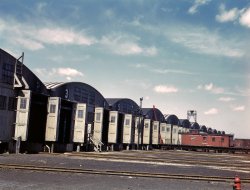
MAY CONTAIN NUTS

Search Shorpy
SHORPY ART

Framed or unframed, desk size to sofa size, printed by us in Arizona and Alabama since 2007. Explore now.
Join and Share
Ad-Free Shorpy
Shorpy is funded by you. Patreon contributors get an ad-free experience.
Learn more.

Recent comments
- Recent view
- Hudson’s Big Store
- Say what??
- Grapes?!
- A Beautiful Moment
- Such joy
- Bethune-Cookman University today...
- Yellow sky at morning
- Side Winder
- Air Quality?
- Sojourner Truth riot
- None were so blind(ed)
- The less famous sister
- Good ol' days?
- Rise and Fall
- Goo Goo Ga Joob
- Ticket Retention
- Not the only one
- Vagaries of War
- Killed by Amtrak
- Back to the Future
- Wanted --
- If you can't stand the light
- Centralized Traffic Control, I believe
- What's really happening
- Heckuva remote control!
- Sometimes — Things Go Bump!
- I SEE THE LIGHT
- Union Switch and Signal Company
- Get That Light Out Of My Eyes
Member Photos
The Shorpy
Print Emporium
Print Emporium
Search Shorpy
Search results -- 30 results per page
- To Florida: 1908
- ...
(The Gallery, Cars, Trucks, Buses, G.G. Bain, NYC, Railroads) ... Posted by Dave - 07/24/2012 - 9:44pm -
![To Florida: 1908 February 28, 1908. "Motorists starting to Florida." Automobilists heading to Race Week at Ormond Beach from New York. View full size. G.G. Bain Collection.
Race WeekNASCAR fans have changed a bit over the years, haven't they?
Race Week?I wonder what "Race Week" was in 1908. Could be cars.
[We know that it's cars -- as the caption says, these people are automobilists. - Dave]
Racing RichLooks like a gang of rich Republicans!
"Race Week"Copied from the Wikipedia article about Ormond Beach, Florida, entire text of which can be found here:
"Beginning in 1902, some of the first automobile races were held on the compacted sand from Ormond south to Daytona Beach. Pioneers in the industry, including Ransom Olds and Alexander Winton, tested their inventions. The American Automobile Association brought timing equipment in 1903, and the area acquired the nickname "The Birthplace of Speed." Driving on the beach is still permitted on some stretches. The city would be renamed Ormond Beach in 1949."
Looks like these folks were headed to what would eventually evolve into the Daytona 500. Who knew auto racing was ever such a formal affair!
Ormond SandsFrom 1903 to 1910, automotive speed found its first home on the smooth, hard sands of Ormond Beach. The longest-held land speed record for the mile in those 8 years was set January 26, 1906 by F. E. Stanley's Rocket Racer, driven by the legendary Fred Marriott. The speed was an incredible 127 miles per hour plus, a record that held for four years in a speed age when records were being broken by the hour; it stood until Barney Oldfield finally broke it in the Lightning Benz by a mere 4 mph.
- From the Birthplace Of Speed Centennial Web site.
The New York Times makes reference to the journey taken by these swells in a contemporary article.
What a contrast!Contrast these well-fed folks with kid in the mill immediately above. No wonder Eugene Debs, the Socialist candidate for president, made such inroads into politics.
And wonder who Big Mama in the center was? A head above the tallest man.
The history of speed in Ormond BeachFrom the City of Ormond Beach website:
http://www.ormondbeach.org/news/Stanley/historyofspeed.htm
(The Gallery, Cars, Trucks, Buses, G.G. Bain, NYC, Railroads)](https://www.shorpy.com/files/images/00188u.thumbnail.jpg)
- Trunk Line: 1938
- ... used this type of signal.
(The Gallery, Philadelphia, Railroads) ... Posted by Dave - 10/30/2017 - 11:11am -
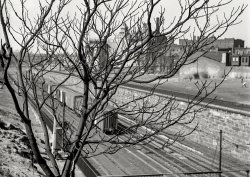
- Car 25: 1905
- ... entertaining and educational site.
(The Gallery, DPC, Railroads) ... Posted by Dave - 08/05/2012 - 4:27pm -
![Car 25: 1905 Circa 1905. "Pere Marquette Railroad parlor car No. 25, exterior." 8x10 inch dry plate glass negative, Detroit Publishing Company. View full size.
Details of CarThe following details come from the book, Mr. Pullman's Elegant Palace Car by Lucius Beebe, 1961:
Superb examples of American Car & Foundry craftsmanship are these two palace cars frin the collection of Arthur D. Durbin [pictures differ from what Shorpy shows]. The Pere Marquette's parlor-cafe No. 25 was in built at A.C.F.'s Jeffersonville shops in 1903 and assigned to the Northern Michigan vacation service on trains No. 1 and 5, and Nos. 9 and 10, the Resort Special. Of this train the public timetable for 1905 of the Great Central route of which the Pere Marquette was a component, says, 'Trains No. 1 and 5 will stop at Little Manistee River (Fishing Camp) on signal,' an index of casual operation in good old summer days. The car was characterized by a curved rear bulkhead with plate-glass windows to match, giving onto an observation platform of uncommon depth.
The Little Manistee River is on the western shores of the lower peninsula of Michigan between Ludington and Frankfort.
GarbageWhat is a bit surprising to me is the amount of litter all over the ground. I'd think a railroad wanting to show off its equipment would want the best representation possible. Or maybe somebody just took a snapshot of a lone car on a siding.
[8x10 glass negatives aren't what most people would consider casual photography. Made with big heavy view cameras on tripods. - Dave]
CheersIs someone proposing a toast from yon window?
GR&ILook like Grand Rapids & Indiana cars in the background. Another railroad providing service to Michigan's "Sportsman's Paradise." Could be at Muskegon or Grand Rapids. I think the GR&I and PM crossed paths at these cities, maybe others.
It's all in the detailSo nice to see the livery and striping details on these Cars. The flourished ends are a nice touch, tradesman at work. In our modern age it is really a treat to see great resource for signpainting restored cars such as these.
HandshakesI can't remember ever seeing a three line air system on any rail cars I am familiar with. Nowadays only one is used.
I have no doubt someone will come along shortly with a perfectly reasonable and technical explanation for us all.
The HosesThe three hoses you see are, from smallest to biggest, the train signal line, the air brake trainline and the steam heat line. The air line for the signal connected to a whistle in the locomotive cab so that the conductor could, through a series of long or short tugs on the valve, signal to stop at the next station, supply more steam for heat, etc.
The air brake line carried 90 to 110 psi compressed air and by reducing the pressure in this line would apply the brakes throughout the entire train.
The third and largest hose supplied steam used for heating the cars, a big improvement over the coal stoves used previously which tended to ignite these varnished wooden cars rather quickly in a wreck!
Multiple HosesOne hose was the air brakes. A second was steam heat. The third may have either been for steam (connections look similar) or for drinking water. Only the air brakes would have been needed on a freight car.
Air Signal lineOne of those extra air hoses on the end of the car is probably for the train air signal line. The other line I am not sure about without looking at some old books I have. The cars probably had stoves for heat and it's not the right size or type of connection for steam heat. It seems like I should know, but I just cannot recall what the third line would be for.
Three LinesThe three lines most likely are: air brakes, steam heat and train signal line. The signal line permitted the conductor (by a small valve located on the bulkhead) to give whistle signals to the locomotive crew.
Re: HandshakesThanks to all who jumped right in with explanations for my previous comment. Shorpy readers are the best! No question remains unresolved very long here. I learn something new every day.
Thanks Dave, for this entertaining and educational site.
(The Gallery, DPC, Railroads)](https://www.shorpy.com/files/images/4a20382a.thumbnail.jpg)
- Fellow Travelers: 1899
- ... high-level concrete platforms.
(The Gallery, DPC, Railroads) ... Posted by Dave - 05/18/2016 - 12:43pm -
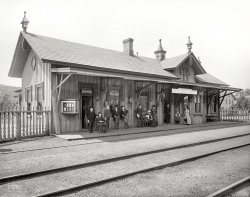
- Watch Your Step: 1933
- ... View full size.
(The Gallery, D.C., Harris + Ewing, Railroads) ... Posted by Dave - 07/03/2014 - 4:58pm -
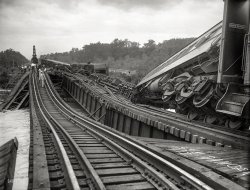
- Smokestack Industry: 1910
- ... Circa 1910. "Maumee River waterfront -- Toledo, O." Railroads represented on the coal cars: Hocking Valley, Kanawha and Michigan, ... split up Conrail.
(The Gallery, Boats & Bridges, DPC, Railroads, Toledo) ... Posted by Dave - 07/24/2015 - 10:08am -
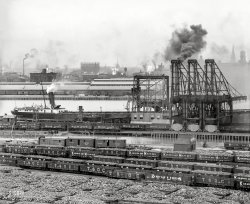
- Flood Relief: 1937
- ...
(The Gallery, Cars, Trucks, Buses, Harris + Ewing, Railroads) ... Posted by Dave - 09/14/2016 - 9:10pm -
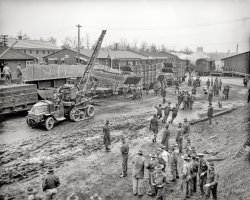
- Sister Act: 1943
- ... on November 24, 1993.
(The Gallery, Marjory Collins, Railroads) ... Posted by Dave - 04/25/2014 - 7:44pm -
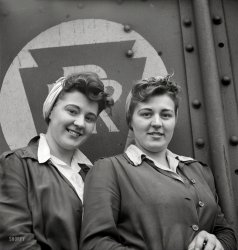
- Fire-Eater: 1942
- ... photography.
(The Gallery, Chicago, Jack Delano, Railroads) ... Posted by Dave - 07/30/2014 - 7:42pm -
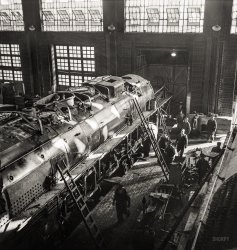
- Depot Mexicano: 1897
- ... of 2.7 million, who would have known??
(The Gallery, Railroads, W.H. Jackson) ... Posted by Dave - 07/29/2018 - 11:36am -
![Depot Mexicano: 1897 San Luis Potosi, Mexico, circa 1897. "Estación del Ferrocarril Central Mexicano (Mexican Central R.R. station)." Glass negative by W.H. Jackson. View full size.
DeathtrapAs a former railroader who did some work as a yard brakeman, my eyes popped out of my head seeing the uncovered culvert right across the switching lead. We did most of our work on the "lead", walking backward while passing signals, often at night. Can't help put think we are looking at a point where more than a few brakies got hurt.
ChurchesI believe that the church is the Montecillo Church, and that we are looking south towards the mountains that make up the Gogorrón National Park. Note the ribbed dome and tile work, although I could not find an image of the west portico of the church. The muddy, rutted area would be the site of a current warehouse and/or a street called Gómez Pedraza.
[Not quite. The church at far left is the Santuario de San Jose; the church on the right is Nuestra Señora del Cármen Parish. - Dave]
San Luis Potosiin case you wondered like me, has a population of 2.7 million, who would have known??
(The Gallery, Railroads, W.H. Jackson)](https://www.shorpy.com/files/images/SHORPY-4a03741a.thumbnail.jpg)
- American Smelting: 1938
- ... effect."
(The Gallery, Factories, John Vachon, Omaha, Railroads) ... Posted by Dave - 08/18/2018 - 11:14am -
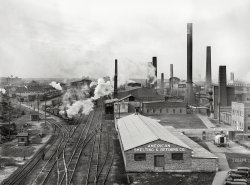
- Grandfathers Street Car, c. 1905
- ... was a bank at the time.
(ShorpyBlog, Member Gallery, Railroads) ... Posted by Bob In Texas - 10/23/2011 - 4:31pm -
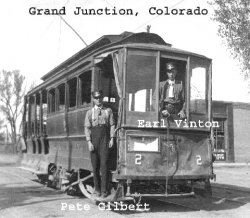
- Rear Brakeman: 1943
- ... caboose shots. - Dave]
(The Gallery, Jack Delano, Railroads) ... Posted by Dave - 08/02/2014 - 4:48pm -
![Rear Brakeman: 1943 March 1943. "Walter V. Dew, rear brakeman, on the Atchison, Topeka & Santa Fe between Chicago and Chillicothe, Illinois, watching the train from the cupola." Photo by Jack Delano for the Office of War Information. View full size.
Essential RR EquipmentCigar boxes.
Old time ingenuityClever use of cigar boxes. Today the brakeman would complain to management and the union. After six pages of paperwork, someone would be designated to hang a couple of metal boxes.
No maintenanceThe railroad didn't spend too much on frills (paint, shelving, etc,), did it?
"You lookin'at me?"Mr. Dew looks like he does not care to have his picture taken!
You never knowwhen half a shoelace will come in handy.
A quizzical smile on his face, as if to say you're down there and I'm up here, in charge.
My FatherWorked for the railroad in the 1930s. He's not with us now but just recently I found out that a pitchfork of his that I use to spread mulch is actually a coal fork, he probably acquired it while working the railroad. It has R&F stamped / burned into the handle. Looking at this picture I noticed those square nuts holding parts of the cabin the brakeman is sitting in together. I have tins of these my father had in his hardware stashes and had never seen them used before. They're the same, flat on one side and sort of curved on top. He worked outdoors on the mechanicals of the train. He used to say that a lot of the guys that worked the boiler shops were gone by the 1950's, they handled a lot of asbestos I guess. He used to think this was the reason.
No frillsDuring the war the maintenance was to keep the trains running and the materials flowing. Taking a caboose or any other needed equipment out of service for cosmetic work just wasn't done
About that cigar boxBack when my father-in-law passed on, I was given the enjoyable task of cleaning out his basement and I found a number of old cigar boxes from HIS father. Back in the late 1930s and 1940s, these were made from a lightweight wood, unlike the heavy cardboard of today, and from what I saw in that basement, they were for a number of aftermarket uses. This photo just shows another one.
Slowing down (probably)One of Walter's jobs was to keep an eye on that gauge, which shows the air pressure in the brake line. Normally (brakes off) it'd be at something like 80 or 90 pounds. When the engineer applies the brakes, the reading would go down; here it's 74 pounds, which probably means at least a little brake application.
If the gauge dropped really low really fast, it probably meant that a brake hose was open, either because the hose burst, or because the train had broken in two. If it dropped somewhat low and stayed there, Walter knew to hang on, because the engineer was stopping hard for some reason.
Today, this monitoring function is done by a box clamped to the coupler of the last car, called a Flashing Rear End Device or FRED. The brake hose on the last car is plugged into the box, and it transmits the current pressure by radio to a display in the cab. (Some engineers call the cab display box "Mary".) As the name implies, FRED also contains the flashing red light that you see on the end of a train at night; it comes on automatically when it gets dark outside.
Chicago and North Western LineIn the King Edward "Invincible" cigar box we may find the maps the brakerman used. The "Chicago and North Western" map we find on top, as we can see the "ball and bar" logo.
According to the Wikipedia entry on CNW, in 1943 the text must have been "Chicago & North Western Line" (1902-1944).
I suppose it was an "Employee Owned" map. here you may find one of 1977. I couldn't find one of around 1943.
Too Gone Too LongAs a rail fan, Walter is on my list of screen saver images and each time his gaze comes round I find Randy Travis looking back at me.
What is missing.As a kid in the 1950s I rode in several cabooses. There were girly pictures on the walls of the cabooses. None here in this pic. Perhaps removed for the portrait?
[There are plenty of girly pics in Jack Delano's other caboose shots. - Dave]
(The Gallery, Jack Delano, Railroads)](https://www.shorpy.com/files/images/SHORPY-8d26296a.thumbnail.jpg)
- Mystery Coach: 1910
- ...
(Technology, The Gallery, Found Photos, Railroads) ... Posted by Dave - 11/28/2014 - 2:37pm -
![Mystery Coach: 1910 From around 1910 comes this 5x7 glass negative showing a rail car fitted with ... what? Post your informed supposition in the comments. View full size.
Instruction car.I'm assuming that this is an instruction car for either an interurban railway or an elevated transit line. In either case you can see the master controller just to the right of the end door. Along the right side is a bank of air compressors while above those are what look like framed study guides or instructions.
Edit, after reading the other post I have to agree. Along the right side are are brake cylinders.
You Brake ItI'm going to guess this is an Air Brake Instruction Car.
I know such cars existed, I've seen references to them on various RR rosters. The contraptions on the right hand side are brake cylinders (air reservoirs and triple valve, Westinghouse K or equivalent.)
The problem with my guess is I can't directly account for the electrical stuff on the left side.
AmenitiesThe spittoon is a nice touch.
And the Answer Is ...... I don't know for sure. But I have a hunch. And I think braking is (so to speak) on the wrong track. Maybe the rectangular objects, radiator-like fixtures and light bulbs on the left are clues.
Motorman's Instruction CarI'm thinking motorman's instruction car -- teaching both brakes and electrics. New York subway had one in 1904, interior shot here, and the exterior here. The window configuration of the latter is very similar, including the larger front left window.
InstructionsPart of the instruction could be how to hit the spittoon. The whisk broom is a nice, dainty touch. So are the hanger straps.
My guess is that it's a transit car converted hastily to a dynamometer car, with plenty of heavy wiring and large resistors to dissipate heat. My dad worked on one in the late '30s to test diesel locomotives for the Milwaukee Road.
Another trackThose may well be air brake assemblies but I suspect they're doing other work, the labeled electrical gear with hefty looking trunking on the opposite side argues against this being a very mobile installation even if the motorman's station is still in place, what we can see of those display boards above the pneumatic gear looks rather maplike.
All this added together with the seven bulb light board, the desk, chair, and spittoon leads me to suspect we are looking at an interurban car repurposed as a switch and signal house either in a small hump yard or on a factory premises.
Certainly InstructionThe equipment on the right side is railroad brake equipment, as deemery said. There is equipment for several cars, so the propagation of the braking commands can be seen.
The equipment on the left is for propulsion control for (as Pudgyv said) an interurban or transit car. On the left, in the foreground (and a bit out of focus) is a jumper connection, used between cars for multiple unit control. The equipment hanging from the ceiling seems to be contactors for motor control. The metal housings near the floor are heaters which may serve as resistors to limit motor current for low speed/slow acceleration. The white "pipes" between the contactors and the floor may be cables between the contactors and the motors mounted on the trucks below the floor. I suspect the white stuff is asbestos insulation; these cables would carry the traction current at around 600 to 750 volts, and hundreds of amps.
Instruction Car.Yes, this most certainly is an instruction car and there are several interesting features: The metal boxes on the left wall next to the floor are electric heaters - as are the same on the right. The cylinder with the arm attached, above, is most certainly a carbon-pile Voltage regulator. The white things I suppose are insulators. The seven glass tubes on the wall I suspect are load or indicator lamps. Hard to tell if this was a 32-Volt (steam line) car or an electric line (600+ Volt) car.
The very curious thing about both sides is the standee straps - guess part of the instruction was carried out while the car was moving.
It appears that this was an open-platform car (looking through the windows).
Another curious feature is the controller to the right of the door. It does not appear to be an engineer's/motorman's brake stand - but could be - maybe. It is too small to control traction motors. Moving around the right side, yes, those are most certainly K Brakes. Have considerable Westinghouse, Pullman, etc. reference material on this era equipment. Note the framed posters above each station. These appear to be valve air channel diagrams. But in addition to the other curiosities, it seems odd that there are no air pressure gauges included with the stations.
Just an observationIt seems that every "break unit" on the right is separated by flexible line like between cars and there's a small reservoir like what would be much larger under each coach car. So I think this might be a mechanical model of a train of coaches to demonstrate what? Same with the electrics on the left with all the electric heater units that are all over the break side also.
[Another observation: BRAKE, not "break." - Dave]
Thanks Dave. I'll never screw up there their they're but otherwise we're free ranging.
IRT Instruction CarThis looks like the New York Subway (IRT) instruction car.
There are slight differences between the two cars pictured but this could be due to modifications over the years, or possibly there was more than one instruction car in the fleet.
Railroad_Sparky is right that the controller appears small. Streetcar controllers usually had bigger cabinets but this one is actually pretty typical of multiple-unit controllers used in rapid transit cars.
Mobile Hot-SpotThis one was easy. You've got your bank of Wi-Fi routers and access points on the left, and your uninterruptible power supplies on the right. Looks like they've opted for the air-cooling option center-right.
New York Is On The Move!
Controller sizeis indeed small. To amplify comments from Railroad_Sparky and SteveLexington, streetcar controllers actually controlled the motors directly, and so had to carry the 600 volts (or so) and the heavy motor currents. Thus, the contactors inside the controller had to be large to carry the large currents, and had to have large separation to extinguish the high voltage arc (spark).
"Multiple Unit" (MU) control was introduced to allow one motorman to control several cars (multiple units) from one controller at the front of the train. Air brakes had been developed already to do this for the brakes, but it took a while longer to control this mysterious 'electricity'. MU controls typically used low voltage control circuits. These were coupled between cars using a multi conductor (7? 14?) plug-in cable. The low voltage would operate heavy duty contactors on each car, which in turn controlled the traction current and voltage. Since the current and voltage are both (relatively) small, a controller can be made much smaller.
You're all wrong.It's the inside of a TARDIS.
I See the LightMaybe the light bulbs came on in a sequence from left to right or right to left to indicate how the brakes engaged in a sequence? Or perhaps they indicated the cleanness and accuracy of the shot of tobacco juice aimed at the spittoon?
Car 824, no doubt It is indeed the interior of IRT Instruction Car 824 - you can barely make out '824' right over the door. I've been in this car - it's at the trolley museum in Branford, Connecticut.
Sister CarsA pair of lovingly preserved (but more conventional) ex-IRT coaches are at home at the Western Railway Museum at Rio Vista Jct. (Suisun City/Fairfield, California). In their "last gasp" service lives, the were WWII-era "Shipyard Railway" cars running between East Bay (Berkeley, Oakland and Richmond) communities hauling war-workers.
https://www.facebook.com/WesternRailwayMuseum
(Technology, The Gallery, Found Photos, Railroads)](https://www.shorpy.com/files/images/SHORPY-148-03AA.thumbnail.jpg)
- San Fran: 1939
- ...
(The Gallery, Boats & Bridges, Dorothea Lange, Railroads, San Francisco) ... Posted by Dave - 09/24/2013 - 5:20pm -
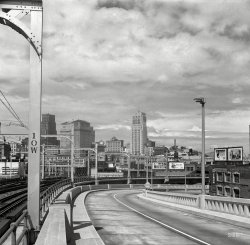
- Basic Training: 1943
- ...
(The Gallery, Chicago, Jack Delano, Pretty Girls, Railroads, WW2) ... Posted by Dave - 03/26/2019 - 3:31pm -
![Basic Training: 1943 February 1943. "Soldier and his girl waiting for a train at Chicago Union Station." Photo by Jack Delano for the Office of War Information. View full size.
AAFTTC Instructor BadgeAt the time, both Chanute Airfield and Scott Airfield were technical training bases, and both are located in Illinois. The corporal is probably from the Chicago area and was home on leave. Now he's headed back to one of these bases to resume his instructor duties.
Built to lastThe same benches are still in use in the great hall. Not tremendously comfortable but somehow soothing in the midst of the hustle and bustle.
His own shoes?I could be wrong here, but I'd been under the impression that shoes for Army dress have been lace up oxfords as long as anyone can remember. Perhaps the corporal is wearing his own shoes until he needs to put on his issue shoes?
Also, they're still using those benches at Union Station. Somebody knows how to refinish that wood or make matching copies.
AAFTTCI believe he's wearing insignia for the US Army Air Force Technical Training Command. Its an AAF patch on his coat and the pin on his lapel I believe is similar to this one, "Sustineo Alas," Latin for "I Sustain the Wings", or "Keep 'Em Flying", their motto.
Non-regulationlow quarter shoes. I doubt those are government issue.
Corporal FlyboyI had to zoom in to confirm he was actually wearing socks, and noticed that he wears the insignia of the Army Air Force Technical Training Command - which, according to Wikipedia, merged with another Command later that year.
(I also like the two women in the background ogling them.)
The PinSeems to be an ID badge with the corporal's photo.
Ain't no hurryShe won't mind if the train's late. Neither will he.
Wonder if Granddad knew himMy grandfather was undergoing training with the AAFTTC in Chicago in February 1943. The odds are low because there were likely thousands of men training in Chicago at that time, but perhaps they knew each other.
I guess I'll never know.
FootgearThe corporal is wearing "monk strap" oxfords, an optional purchase for officers, who have always had to procure their own uniforms privately rather than their being issued by the various services.
Such uniform embellishments and upgrades on the part of enlisted men were fairly common in the "glamor" branches like the Army Air Force. He'd have gotten away with these shoes off-post, but they'd mark him for unfavorable attention at a formal inspection. In between those two conditions of scrutiny, a crap shoot.
[My mother had an airman officer friend from Texas during WW2 who always wore cowboy boots. - Dave]
His shoes??His shoes?!? Forget about his shoes, what about her little fur booties with the half-wedge heels? Those babies are FIRE.
(The Gallery, Chicago, Jack Delano, Pretty Girls, Railroads, WW2)](https://www.shorpy.com/files/images/SHORPY-8d13095u.thumbnail.jpg)
- Routing the Rails: 1943
- ... use)
(The Gallery, Kodachromes, Chicago, Jack Delano, Railroads) ... Posted by Dave - 05/15/2016 - 11:40pm -
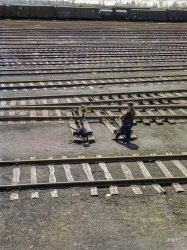
- Proviso Yard, Chicago: 1942
- ... Dad.
(The Gallery, Kodachromes, Chicago, Jack Delano, Railroads) ... Posted by Dave - 07/30/2012 - 10:00pm -
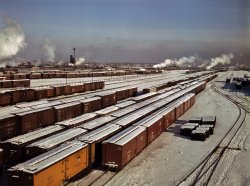
- Troop Train: 1943
- ... and more often than not lacked air conditioning. Railroads pressed their older heavy-weight and light-weight stock into service ... the trading to continue.
(The Gallery, Jack Delano, Railroads, WW2) ... Posted by Dave - 06/17/2014 - 6:55am -
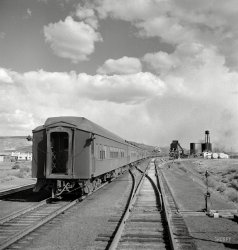
- Toronto Depot: 1900
- ... 1906, B & W shot from 1922.
(The Gallery, DPC, Railroads) ... Posted by Dave - 12/08/2018 - 2:23pm -
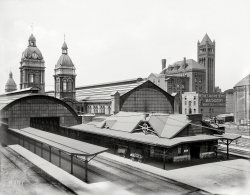
- Vicksburg Panorama: 1909
- ... in the time machine.
(Panoramas, Boats & Bridges, DPC, Railroads, Vicksburg) ... Posted by Dave - 02/25/2014 - 11:33am -
![Vicksburg Panorama: 1909 The Mississippi River circa 1909. "Vicksburg waterfront." A panorama made from three 8x10 glass negatives (the widest image, pixel-wise, that Shorpy has ever posted -- be sure to scroll all the way over to the right). The nine-story skyscraper is the First National Bank. Detroit Publishing Company. View full size.
PanoramaI know of one panorama William Henry Jackson composed for Leadville, CO, although I don't know if it was while he worked for DPC. His "stitching" technique involved three large prints on easels, which he re-photographed. I found the process documented in a series of photos in the Denver Public Library.
Chinese groceryWhat a fascinating image. An unexpected surprise was the "Quong Yulin & Co." grocery, a few blocks away from "Sol. Fried" store.
Wikipedia currently lists Vicksburg at less than 1 percent Asian. Vicksburg's 165-year old Synagogue now has just 20 members.
I wonder how much of the construction along the waterfront is post-war. Vicksburg experienced quite a boom in population growth between 1860 and 1870.
Earlier components?I seem to recall parts of this (great) panorama as previous Shorpy photos. Can someone post links to them?
[One photo. Our Search box would take you here. Waiting in the wings, there is at least one other version of this scene taken the same day, for a total of three. - Dave]
Remarkable detailThis is a remarkable image. I wonder if Detroit Publishing produced any more of these stitched multi-image panoramas.
[Click the "Panoramas" link above the photo. The stitching is all done by me, and Photoshop. - Dave]
No Horseless CarriagesTypically photos of this vintage display horse & buggies AND early automobiles. Was Vicksburg behind the times or could it be the photo pre-dates 1909? Either way, this a facinating snapshot of a moment in time along the Mississippi River.
[The First National Bank building was completed in 1907. - Dave]
Seek and you shall findWay on the right, a Coca-Cola sign.
[Actually there are three. - Dave]
Very DirtyAn amazing photo. The thing I am thinking about is that all the ladies seem to be wearing long white dresses and the streets appear to be all dirt. Their clothing must have gotten filthy in a very short time from simply walking the streets. I am also loving the Steam Boat Exchange Saloon, I wonder what curious sights were beyond those doors ??
Merchants DespatchWell weathered.
Above the Falls Cityare buildings in disrepair, could they be civil war casualties?
[From 50 years earlier? That's fire damage. - Dave]
Coca-Cola and VicksburgVicksburg was home to the Biedenharn Candy Company, the first bottler of Coca-Cola. Although the drink was created in 1886, it was sold mainly at druggists and soda fountains. Biedenharn started bottling the drink in 1894.
Did the channel change?I notice from the satellite view that the channel fronting most of the city is now the Yazoo River, not that there is much of a waterfront left. Such a channel change is something that General U.S. Grant unsuccessfully tried to engineer in 1862-1863, but it looks like nature finally did what 19th Century military engineering could not, as nature always does.
Many of these buildings remainHaving lived in Vicksburg, I can tell you that while a number of the buildings shown along the Mississippi riverfront have been torn down and replaced, still, many of the buildings pictured in this panorama are still there, being re-purposed with new businesses and tenants through the years.
On Washington Street, the street the First National Bank building is on (still there, its main floor used still as a bank with professional offices on the other floors), many of these buildings still remain. You'll notice the many steeples and cupolas on the skyline.
Going from left to right, the first steeple is that of Christ Episcopal Church (still there); the two-storied brick building with the cupola right on the river (with train cars pictured in front) is the old L&N Railroad Depot, now a Visitor Center. Atop the hill, the building with columns on all sides and the cupola on top is the old Warren County Courthouse (built in the late 1850s), now the Old Courthouse Historical Museum. Right across the street from the Old Courthuse, you see the "steeple" of the City Jail. Past the First National Bank Building, going east up the hill is the tower of the Carroll Hotel (a picture of which was posted on Shorpy several years ago -- The Carroll was torn down sometime in the late '40s or early '50s).
The church that is pictured was St. Paul's Catholic, destroyed in the early 1950s when a tornado did a lot of damage as well as killing a number of people. A new church was built on the site in the 1950s. The squareish tower is the top of the Army Corps of Engineers headquarters, now used as the HQ of the Mississippi River Commission. The tall steeple at the left is Holy Trinity Episcopal Church. At the extreme left, the top two floors of the light-colored brick building (another skyscraper of five stories!) was a popular department store known as The Valley, which did business until sometime in the late 1970s or early '80s. The building has been converted into condos.
At this time, the downtown streets of Vicksburg were not dirt but were paved with brick. The streets going east, up the bluffs from the river were (and still are) paved with cobblestones in order that vehicles can get some traction going up and down. When I started driving as a teenager in the 1960s, I was told that if you could learn to drive on the hilly streets of Vicksburg -- in a car with a standard transmission -- you could drive anywhere!
Alice Used to be FrankThe sternwheel packet Alice B Miller, seen here to the right, was built in 1904 at Jefferson, Indiana, as the Frank B. Hayne. She became Alice in 1908 and met her demise by fire in Vicksburg in 1915. Source: University of Wisconsin LaCrosse, Murphy Library.
Superb, engrossing imageFascinating - rewards hours of scrutiny! Just wanted to say a sincere thank you for putting this one together and sharing it with us.
Depot at VicksburgThis view shows the Yazoo & Mississippi Valley Railroad (Y&MV) depot, not the L&N.
Great panos!Thanks for the link to the panoramas you've stitched. I now have to look forward to hours in the time machine.
(Panoramas, Boats & Bridges, DPC, Railroads, Vicksburg)](https://www.shorpy.com/files/images/SHORPY_Vicksburg_Panorama_4.thumbnail.jpg)
- Milwaukee Yards: 1941
- ... of it I would.
(The Gallery, John Vachon, Milwaukee, Railroads) ... Posted by Dave - 03/22/2020 - 12:44pm -
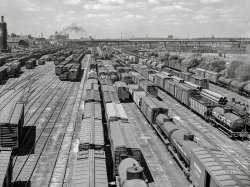
- Ghosts of Atlanta: 1864
- ... principal hotel at the time; tracks of three of the chief railroads here crossed Whitehall Street, on which the "Intelligencer" office ... Posted by Dave - 07/31/2012 - 7:20pm -
![Ghosts of Atlanta: 1864 "The War in the West." 1864 photo (half of a stereograph) by George N. Barnard. Atlanta Intelligencer newspaper office by the railroad depot. Exposure times were so long that anyone walking appears only as an ectoplasmic blur. View full size. Note tents in background and troop train with soldiers atop the boxcars.
where was this in Atlanta?Anyone know where this was in Atlanta? Looking for an approximate street address.
Masonic lodgePerhaps the large masonic lodge in the background is still standing ... might be a clue.
Try the main PeachtreeTry the main Peachtree Street / locate the address of the Atlanta terminal at the time / try Five Points area / could it be near Kennesaw? good luck--former Atlanta area resident and interested in knowing as well.
Masonic Lodge (1864) in AtlantaI have been researching, and it appears that the Masonic Lodge, and another building called The Trout House were on Decatur St. in Atlanta.
Click on this link http://memory.loc.gov/service/pnp/cwpb/03300/03304v.jpg (Trout house beside Masonic lodge.)
Here is a site with several images of Georgia during the Civil War...scroll down to 1864, and you will see the listing for this picture.
http://www.cviog.uga.edu/Projects/gainfo/cwphotos.htm
Now I am off to find out if this Masonic Lodge is still standing.
Where was this in Atlanta? (answer)I have been checking around and asking around about where this area in this photo might be, and a new friend on an Atlanta school site gave me this information...
Quote:
"Decatur Street is one of the main 5 roads that leads to Five Points, which basically is the center of downtown Atlanta, and was the center of town at that time. I think, but not sure, based on that picture and some of the other photos of the Union troop encampments, etc, that the Masonic Hall and Trout House were pretty close to what is now 5 Points. Most of that area of Decatur Street now has been renovated over the last 25 years and is where Georgia State University is located. I am fairly certain that neither of these structures is there any longer. When I went to GSU in the 1960's, I travelled almost the length of Decatur Street to get there. I do not recall ever seeing either of them, even back then, at that time, and to date, much of that area was torn down with Urban Renewal funds from the feds. It was mainly run down buildings and older businesses. It is possible that one of those run down buildings may have been one of the structures. However, Decatur Street runs east for a few miles, and they may have been futher east than I think. During the Civil War era, though, most of that area was rural. The actual Battle of Atlanta that is depicted in the Cyclorama painting took place away from the center of town out in the rural area of Decatur St/Road & what is now Dekalb Ave.(same road).
At least this clears up a little bit for us all.
sherri
Underground AtlantaMy guess is that this was taken near the corner of Peachtree SW (then Whitehall) and Wall St. That would put it in what is now Underground Atlanta, I think.
Whitehall StreetWAR-TIME CAMP IN ATLANTA, GEORGIA, IN THE OLD CITY PARK
At the extreme left is the old Trout House, the principal hotel at the time; tracks of three of the chief railroads here crossed Whitehall Street, on which the "Intelligencer" office fronted.
http://docsouth.unc.edu/fpn/gordon/ill5.html
Whitehall & AlabamaMy guess is the corner of Whitehall and Alabama Streets looking northeast. Currently Peachtree Street. Back then Peachtree changed to Whitehall south of Five Point.
Atlanta DepotNoticed that the same photographer walked a block or so to the right after taking this one. Does that help narrow the location down?
Masonic LodgeBy the Masons' own records, the Lodge in the background stood on the corner of Lloyd (now Central Avenue) and Alabama Street, at south angle. So I would guess that if we're one block west it's on what is now Pryor Street or if two blocks Peachtree.
http://maps.google.com/maps?q=Alabama+Street+Atlanta&oe=&ie=UTF8&hl=en&h...
Ref: http://www.ap59.org/html/atlanta_59.html
HandbillIf you look on the corner of the building, you can just make out the word "frolic." Can't quite tell what comes before.
[Cobblers? Gobblers? - Dave]
Atlanta Intelligencer office I have mapped many of Barnard's photographs on this interactive map. This picture is marked as Pushpin 10.
The playbill pasted to the building in the foreground advertises a stage show by Union troops to raise money for Mrs. Rebecca S. Welch, whose husband and son (Confederates) were both killed in Virginia.
The Bottom of the Playbill Reads:
Benefit Night / Maj(?) I. Smith / Leader of the Band / of the 33rd / Mass. / The Laughable Pantomime / The Cobbler’s Frolic / at the Atheneum / tonight / Saturday /Nov. 5th
Location of this buildingThis building was located close to where the Peach Drop tower currently is, at Underground Atlanta. Because of the viaduct that created Underground Atlanta, it would have stood below the current street level. It was on Whitehall Street (now Peachtree).
(The Gallery, Atlanta, Civil War, Geo. Barnard)](https://www.shorpy.com/files/images/03359u.thumbnail.jpg)
- Frosty the Brakeman: 1943
- ... treasure!
(The Gallery, Chicago, Jack Delano, Railroads) ... Posted by Dave - 11/06/2013 - 8:28pm -
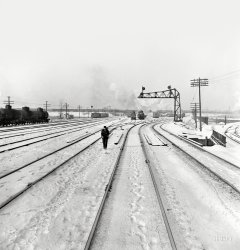
- Kittycat Express: 1914
- ... -tterrace]
(The Gallery, Cats, Harry W. Frees, Railroads) ... Posted by Dave - 09/12/2013 - 8:29am -
![Kittycat Express: 1914 1914. "Kittens in costume riding miniature locomotive." And it seems like just yesterday (or last week) that these guys were being pushed around in a stroller -- they grow up so fast. Photo by Harry W. Frees. View full size.
A Cat-egory of His OwnI find all of Harry W. Frees images ridiculously entertaining and hope his work gets elevated to the homepage list of photographers right along with the likes of Ansel Adams. Heck, since Frees and Adams were contemporaries for a few decades, I like to imagine that these kittens might have chugged through the Sierra Nevadas in my mental Frees-Adams mash-up.
The bane of every model RR photographerNot kittens, but not having all wheels on the track.
Harry Frees Story BooksSomeone, I think my grandmother, gave my son a book called Four Little Kittens just chock full of these kinds of pictures. He's 30 now so this was quite some time ago. The four kittens were named Buzz, Fuzz, Suzz, and Agamemnon, had a variety of adventures, and had to be tended to by their mother Samantha. All were adorably dressed just like this with cute little props. No credit to Mr. Frees in the book, just a note that the book is "Our version of the antique original." Anyway, some time after I saw this picture yesterday I just happened to find the book. I wonder if it really was an "antique original" or if someone just made a mash-up of a bunch of Harry Frees pictures.
[The original did carry Frees' credit. -tterrace]
(The Gallery, Cats, Harry W. Frees, Railroads)](https://www.shorpy.com/files/images/SHORPY_04044u.thumbnail.jpg)
- Adams Express: 1901
- ... a big project!
(The Gallery, D.C., D.C. Street Survey, Railroads, Streetcars) ... Posted by Dave - 08/23/2020 - 11:02am -
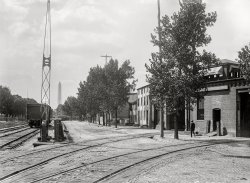
- Bumper Crop: 1941
- ... were laid flat when nailed.
(The Gallery, Agriculture, Railroads, Rural America, Russell Lee) ... Posted by Dave - 10/20/2018 - 3:42pm -
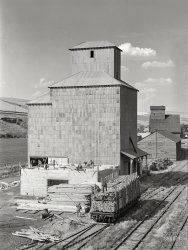
- Utah Copper: 1942
- ... standards.
(The Gallery, Andreas Feininger, Mining, Railroads) ... Posted by Dave - 08/03/2017 - 4:34pm -
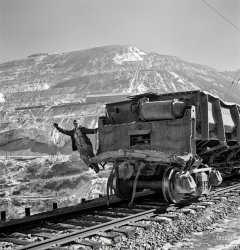
- Locomotive of Tomorrow: 1939
- ... this one .
(The Gallery, Gottscho-Schleisner, NYC, Railroads) ... Posted by Dave - 05/13/2015 - 9:40am -
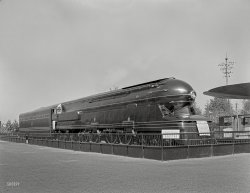
- Proviso Freight House: 1943
- ... for the OWI.
(The Gallery, Chicago, Jack Delano, Railroads) ... Posted by Dave - 08/10/2012 - 5:39pm -
